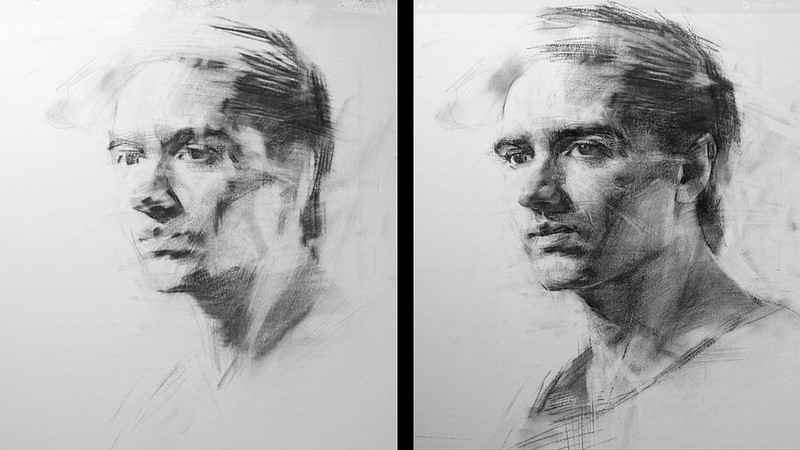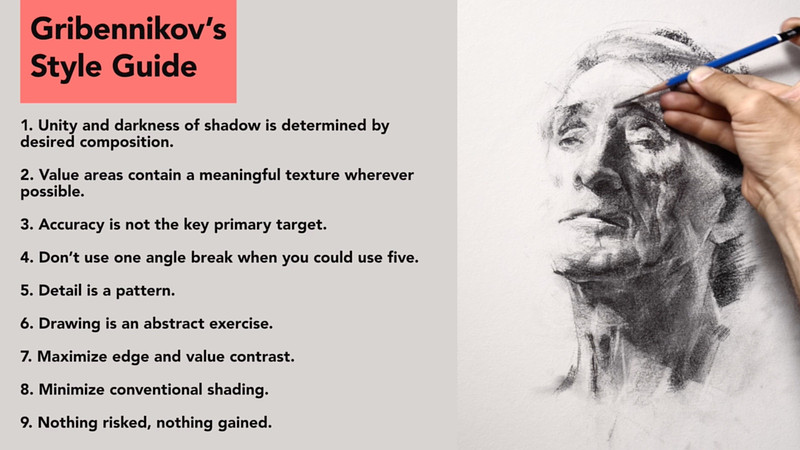How To Study Style
December 4th
How to Study Style
Style is the part of drawing everyone recognizes instantly but almost no one knows how to study.
Most realist students practice faithfully yet still struggle to understand why one drawing feels alive while another feels inert. This course offers a way through that uncertainty. It reveals the structure behind an artist’s decisions and provides a clear method for studying style without the usual guesswork.
The material here treats style as a set of choices that can be broken down, tested, and ultimately absorbed until they become part of one’s own vision.
Course Focus
The lessons in this course build a framework for seeing style through the lens of structure, shape design, value organization, edges, mark-making, and composition. Instead of copying the surface of a drawing, you learn to read the decisions that gave the drawing its character. This approach chills out the sense of information overload that online students often experience and replaces it with a clear sequence of what to look for and why.
You'll be guided through drawing lessons of varying complexity, master study breakdowns, and comparative exercises that sharpen perception. The aim is to help the eye notice the patterns, exaggerations, omissions, and priorities that make an artist unmistakable.
What the Course Contains
- Full portrait workflow analyses across multiple projects
- Master study demonstrations with step-by-step commentary
- Style-comparison studies that train you to see differences with precision
- Practical exercises that build awareness rather than accumulate tricks
Every demo is recorded in real time to show not only what to do, but why it matters.
What You Will Learn
A Clear System for Reading Any Artist’s Style
A process for decoding style so you can understand the intent behind another artist’s decisions rather than merely copying them.
How to Build a Personal Visual Vocabulary
A way to absorb influences without becoming derivative. You’ll learn what to borrow, what to refine, what to discard, and how to integrate these new ideas into your visual world.
How to Prioritize What Actually Matters
Most of the frustration online students face- overthinking, getting lost in detail, copying mindlessly- comes from not knowing what to look at first. This course teaches a hierarchy that clarifies what contributes to style and what is simply ornament.
How Style Shapes Emotion, Mood, and Presence
You’ll learn to see how artists create intensity, stillness, tension, or elegance through structure alone and how to bring those qualities into your own drawings with intention.
How to Make Work That Feels Cohesive and Alive
Once the structure of style is well understood, your decisions take on direction, intention, and finally, character.
Here’s What You Get
- A repeatable method for studying style that can be applied to any artist or genre.
- Real-time demonstrations that model how style emerges naturally from structure.
- Thoughtful exercises that challenge you to see differently rather than work harder.
- Tools for your own studio practice that help the work feel unified, expressive, and unmistakably yours.
About me
More than fifteen years of teaching realist drawing and painting—shaped by my time at The Florence Academy and a lifelong obsession with drawing—have taught one thing: style i’s how an artist says what they mean, and how your work stops blending into the crowd and starts sounding like a voice.
My own portrait work relies on that balance between precision and just-vibes, and my teaching reflects the same priorities. In this course I wanted to strip away mystique and replace it with practical methods, so students can make a drawing work rather than hoping it works. It’s built to help online art students move past the familiar frustrations: feeling confused by other artists’ decisions, struggling with inconsistency, achieving accuracy but not vitality, and sensing that style is always just out of reach.
Here, the process is laid out with clarity. The path is concrete. And style becomes something you can finally study, understand, and put to work in your own hands.
Graphite pencils from 2H to 10B, Stonehenge white or warm white paper, kneaded erasers, mono-zero erasers- both round and chisel tip, and a totally risk-positive attitude 👌
Anyone who wants to understand how style works so they can make their work more personal and expressive.
Yes. Each lesson includes short, practical exercises designed to train your eye without overwhelming you.
Portraits are the main vehicle, but the principles apply to any subject—shape, value, and edge choices carry across still life, figure, landscape, and imaginative work alike.







